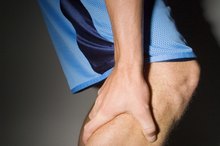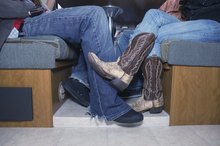What does fact checked mean?
At Healthfully, we strive to deliver objective content that is accurate and up-to-date. Our team periodically reviews articles in order to ensure content quality. The sources cited below consist of evidence from peer-reviewed journals, prominent medical organizations, academic associations, and government data.
- Clinical Orthopaedics and Related Research: Back Pain and Total Hip Arthroplasty -- A Prospective Natural History Study
- Clinical Orthopaedics and Related Research: Back Pain and Total Hip Arthroplasty -- A Prospective Natural History Study
- BMC Musculoskeletal Disorders: Modifying Patterns of Movement in People with Low Back Pain -- Does It Help? A Systematic Review
- BMC Musculoskeletal Disorders: Modifying Patterns of Movement in People with Low Back Pain -- Does It Help? A Systematic Review
The information contained on this site is for informational purposes only, and should not be used as a substitute for the advice of a professional health care provider. Please check with the appropriate physician regarding health questions and concerns. Although we strive to deliver accurate and up-to-date information, no guarantee to that effect is made.
Limping & Back Pain
Limping can be the origin of back pain or a symptom of back pain. Limping occurs when pain, symptoms or weakness in the back or lower extremity alters your gait 1. The leg on the injured side is not functioning correctly, so it lacks its proper movement pattern. This causes other areas of the body to compensate, which leads to uneven stress or a larger than normal work load. Individuals take between 5,000 to 10,000 steps a day on average -- and limping can cause back pain.
If you are experiencing serious medical symptoms, seek emergency treatment immediately.
Nerve Impingement
Signals from the brain to the legs travel down the spinal cord, through the spinal nerve roots, which pass between the lower back vertebra, into the legs. Lack of flexibility in the low back causes pinched nerves that lead to symptoms in the leg. These symptoms can include:
- pain
- numbness
- tingling
- burning
- weakness
- tightness
- spasm
- diminished reflexes
The source of the leg pain is the pressure on the nerve in the lumbar spine, and limping can be a direct result of this pinched nerve.
Low Back Pain
What Causes Sciatic Nerve Pain When Walking?
Learn More
Low back pain can result from muscle spasm, muscle strain, muscle tightness or ligament injury. When the lumbar spine is not working correctly, other areas -- such as the pelvis or hips -- must compensate for it. This additional workload fatigues the muscles and joints, leading to pain, injury or limping.
Hips and Pelvic Joints
The pelvis and hips function as major movers and supporters of the body.
Knees
4 Symptoms of Leg Weakness You Should Learn to Recognize
Learn More
Knee conditions, including pain, weakness and inflexibility, lead to improper mechanics of the knee. The joint motions of the lower extremity while walking are interdependent -- loss of motion in one joint negatively impacts all the other joints. The inability of the knee joint to bear weight, or bend and straighten completely leads to an altered walking pattern, which places additional load on other joints. This additional workload leads to muscle weakness, repetitive strain injuries and pain.
- Knee conditions, including pain, weakness and inflexibility, lead to improper mechanics of the knee.
- The inability of the knee joint to bear weight, or bend and straighten completely leads to an altered walking pattern, which places additional load on other joints.
Ankle, Foot and Toes
These structures work in unison to support and move the body. Conditions affecting the feet and ankles are often the origin of a limp. Eventually this altered walking pattern leads to pain in the body parts affected by and compensating for the limp, including the low back spine.
Related Articles
References
- Clinical Orthopaedics and Related Research: Back Pain and Total Hip Arthroplasty -- A Prospective Natural History Study
- BMC Musculoskeletal Disorders: Modifying Patterns of Movement in People with Low Back Pain -- Does It Help? A Systematic Review
- National Institute of Neurological Disorders and Stroke. Low Back Pain Fact Sheet. Updated August 13, 2019.
- American Academy of Orthopedic Surgeons. Low Back Pain.
- Biyani A, Andersson GB. Low back pain: pathophysiology and management. J Am Acad Orthop Surg. 2004;12(2):106-115.
- Goel A. Is it necessary to resect osteophytes in degenerative spondylotic myelopathy? J Craniovertebr Junction Spine. 2013;4(1):1-2. doi:10.4103/0974-8237.121615
- National Institute of Arthritis and Musculoskeletal and Skin Diseases. Spinal Stenosis. Updated August 2016.
- American Academy of Orthopaedic Surgeons. Spondylolysis and Spondylolisthesis. 2016.
- Scherl SA. Adolescent idiopathic scoliosis: Clinical features, evaluation, and diagnosis. UpToDate. Updated November 22, 2019.
- Casazza BA. Diagnosis and Treatment of Acute Low Back Pain. Am Fam Physician. 2012;85(4):343-350.
- National Center for Complementary and Integrative Health. Mind and Body Approaches for Chronic Pain: What the Science Says. 2019.
Writer Bio
Dr. Donald A. Ozello, D.C., is the owner and treating doctor of chiropractic at Championship Chiropractic in Las Vegas, Nevada. He is a writer for MyHealthZine.com, The Las Vegas Informer, SpineUniverse.com, "OnFitness Magazine" and various other print and online publications.







